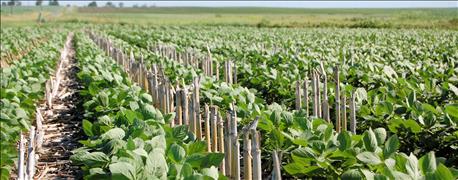December 28, 2015

In a new Economic Research Service report, USDA researchers examine data on conservation practices on land planted to corn, soybeans, cotton and wheat, finding that conservation practice adoption varies widely across these crops, and across regions.
Related: New ag database helps tackle water conservation issues
In general, southern and eastern regions use no-till/strip-till and cover crops more intensely than other regions. Even within individual farms, practice adoption can vary, the report says.
The report also found:

Roughly 40% of combined acreage of corn, soybean, wheat, and cotton were in no-till/strip-till in 2010-11, according to a new USDA ERS report.
• Roughly 40% of combined acreage of corn, soybean, wheat, and cotton were in no-till/strip-till in 2010-11 (89 million acres per year), with adoption rates higher for some crops and some regions.

• 56% of all land used for corn, soybeans, wheat, and cotton was on farms that used no-till/strip-till on at least part of their cropland in 2010-11: 23% of land was on farms that used no-till/strip-till on all land in these crops while 33% was on farms that used a mix of no-till, strip-till, and other tillage practices.



Nitrogen application data >>
~~~PAGE_BREAK_HERE~~~
• Fall application of nitrogen accounted for 20% of nitrogen applied to corn in 2010 (29% of acres). Cotton producers applied only 7% (on 14% of acres) in the fall of 2007.
• Split application of nitrogen fertilizer accounted for 59% of nitrogen applied to cotton in 2007 (64% of acres). In 2010, corn farmers applied 22% of nitrogen fertilizer (on 31% of acres) after planting.
• Farmer-reported nitrogen rates are higher than benchmark application rates (based on estimated plant uptake and designed to minimize nitrogen losses to the environment) for 36% of corn acres, 19% of cotton acres, 22% of spring wheat acres, and 25% of winter wheat acres.
Related: 5-year study offers look at tillage effects on soil health
• Using multiple nutrient-management practices has greater potential to reduce the loss of nitrogen than using a single practice. Only 24% of cotton acres and 6% of corn acres combined four nutrient- management practices: (1) no application in the fall, (2) some application after planting, (3) nitrogen application at rates below a "benchmark," and (4) fertilizers incorporated or injected below the soil surface.
• Cover crops were in use on less than 2% of total cropland (for all crops) during 2010-11 (6.8 million acres), with adoption rates higher in some regions.

You May Also Like




